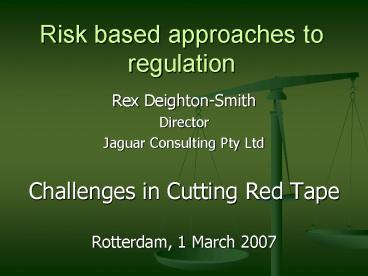Risk based approaches to regulation
1 / 16
Title:
Risk based approaches to regulation
Description:
'Development of a risk based approach will be essential as part of any ... acceptance (voluntary assumption of risk vs policy rules) (workers vs bikers?? 1:1000 risk) ... – PowerPoint PPT presentation
Number of Views:66
Avg rating:3.0/5.0
Title: Risk based approaches to regulation
1
Risk based approaches to regulation
- Rex Deighton-Smith
- Director
- Jaguar Consulting Pty Ltd
- Challenges in Cutting Red Tape
- Rotterdam, 1 March 2007
2
Risk based approaches to regulation
3
The OECD Recommendation
- Including risk analysis in this process of
adjusting the responsibilities and roles of the
public and private sectors as may follow from a
change in the content of regulations. - Development of a risk based approach will be
essential as part of any redistribution of
responsibilities between the state, the private
sector and civil society in an overall effort to
produce effective responsible regulation.
4
Practice in OECD Countries
- Risk assessment formally required to be used in
RIA in most OECD countries - But widely varying amounts/types of guidance on
performing risk assessments - A lack of clear decision-rules or guidelines
5
Threshold test
- Most RIA guidelines require this step
- It is a longstanding (1995) OECD best practice
- Its use recognises the limits to govt action
- But how is it to be conducted in practice? What
rules to apply? - This is a risk based test but,
- Quantitative acceptable risk thresholds are
almost unknown to govt policy
6
An exception the UK
- Fatality risks of 1 in 1 million years broadly
acceptable. - Fatality risks of 1 in 10 000 years at the
boundary between tolerable and unacceptable risks
for members of the public who have a risk imposed
upon them in the broader interests of society. - Fatality risks of one in 1 000 years the
boundary between tolerable and unacceptable risks
for workers who voluntarily assume a risk. - Source HSE (2001), pp 44-5.
7
Value of a statistical life (VSL)
- A fundamental element of benefit/cost analysis
for health/safety based regulation - Can be seen as implicitly setting an acceptable
risk threshold - Setting a given VSL limits the ability to pursue
small risk reductions because BCA outcomes will
usually be negative - But relatively few countries provide explicit
guidance on VSL
8
VSL - examples
- EC Base case 1 million, sensitivity testing at
2.5m and 0.65m - US Most values are in the range 1 million to
10 million - Canada ditto
- UK BCA guide cites Dept. of Transport figure of
1.145 million
9
Results of the lack of detailed risk assessment
rules
- Hahn, Viscusi, etc point out losses of regulatory
effectiveness - Widely varying cost per life saved (-8bn to
36bn!) - Scope to both improve regulatory effectiveness
and reduce costs by better targeting regulatory
activity - Will also improve regulatory credibility
10
Some conclusions
- Hahn concludes the VSL figure used has little
influence on proportion of regulations passing a
BCA - Similarly, the discount rate chosen has limited
impact - Rather, the key is ensuring that some figure is
adopted and quantification occurs
11
Conclusions
- Neither formal requirements for risk analysis nor
RIA have substantially moved practice toward
consistent, rational approaches to risk - Partly due to continued lack of quantification in
RIA - But Hahn shows that inconsistency is rife even in
US, where more quantification occurs
12
Explaining the lack of progress
- Government is essentially responsive to
subjective risk perceptions - But subjective and objective risk can differ
- Voluntary assumption
- individual control
- outrage (risk less acceptable if associated
with negligent behaviour) - Understanding of risk
- Social amplification
- Risk perceptions (reality vs perception)
- Differences in risk acceptance (voluntary
assumption of risk vs policy rules) (workers vs
bikers?? 11000 risk)
13
Explaining the lack of progress (2)
- Political imperatives
- (organised lobbying, narrow perspectives)
- Views on the reach of government
- (How much can govt do? Is it desirable?)
- Uncertainty
- (What is the real size/nature of the risk? How
to respond to lack of knowledge?)
14
Implementing the OECD recommendation
- Better implementing risk perspectives in
regulatory design, implementation enforcement,
by - Establishing a detailed risk policy
- Includes setting VSL, acceptable risk threshold
discount rate figures that are broadly acceptable - Seeking broad support for it
- Active dialogue on risk regulation to establish
legitimacy (e.g. Better Regulation Commission
Whose Risk is it Anyway)
15
Implementing the OECD recommendation
- Addressing risk perceptions
- (Aligning subjective objective risk)
- Policies on dealing with uncertainty
- - How much conservative bias/safety margin?
- Integrating risk assessment with RIA
- Requires improved RIA guidance/quality control
- Addressing risk issues in compliance/enforcement
policies - Esp. targeted inspections, resourcing in line
with risk levels (see Hampton).
16
Conclusions
- The role of risk assessment is widely recognised
- But comprehensive policies to ensure
implementation are largely absent - Both political and technical impediments exist
- But co-ordinated action to address these offers
the possibility of major improvements - Gains in greater regulatory effectiveness,
reduced cost, enhanced legitimacy are potentially
massive.































